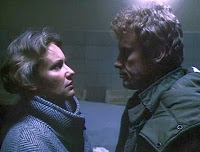A Very Long Engagement is a breathtaking film. Director Jean-Pierre Jeunet, has quite remarkably brought together a heady mix of childhood innocence, the horror of war, sexual awakening, romance, mystery, intrigue, and drama; using some brilliant acting, a gripping 'searching for the truth' plot, and absolutely gorgeous filming. The results are highly unusual, emotionally gripping and truly memorable.
The main storyline centres on the fate of one of five French soldiers condemned to death on the Western Front for alleged self-mutilation, in the attempt to gain medical discharge from the carnage of The Somme. This soldier, a boy from Brittany called Manech (Gaspard Ulliel), lies in a military cemetery, according to military files, but his fiancee, Mathilde (Audrey Tautou) refuses to believe it. She takes on years of investigative work in order to establish exactly what happened on one fateful day in one particular trench called "Bingo Crepuscule".
The plot unfolds (with the help of a narrator), from the perspective of Mathilde, as she pieces together the story - and reminisces about her happy life before the war. As her knowledge grows, and she tracks down various witnesses, the audience is allowed to see more of the wartime action. As such, the film moves back and forth between the sun-drenched dreamy Brittany countryside (almost sepia-like in reminiscence); and the muddy, ghastly Somme. The intersection of the saturated colours of Brittany, and the colourless water-saturated battlefield is chilling. The battlefield scenes are absolutely heart-wrenching, and amongst the most vivid portrayals of The Western Front I have ever seen. The recreations of mid-20th Century Paris are incredible too. Tautou caries the part of Mathilde superbly, combining her physical and emotional frailty with a steely determination around which the whole story revolves. The appalling conditions, and dreadful suffering of the trenches is also offset against some very funny moments involving Ticky Holgardo as a larger than life private detective and Jean-Paul Rouve as a hilarious postman. An array of excellent supporting cast members, add to the brilliance of this film.
The film carries a (15) rating in the UK, primarily because of the horror of some of the battlefield scenes, and some post-war reprisals against bad officers. The rating is also earned by a sexual sub-plot, involving Jodie Foster (acting in French!) as the wife of a soldier desperately trying to get pregnant in his absence, to add a sixth child to the family to qualify him for discharge from the forces.
A Very Long Engagement also adds something of a French perspective to the Centenary Memorials of the battles of the First World War. Obviously we are more used to the British perspective here, and Hollywood has looked a American and Canadian experiences; but this is a reminder that men from all over France were called up for the conflict too.
I wonder if the power of this film is because it crosses so many boundaries of genre? Perhaps too many films stick in one groove and work that theme to it's conclusion. A Very Long Engagement, is in places a romance, at others an action film, it has moments of great delicacy and passion, others of great sorrow, yet shot though with flashes of humour too. Real life doesn't exist in single genres, so why do so many films? Delightfully, it does all these different things so well, that the result is not half-baked, and incoherent; but totally absorbing and very moving. The things which stick most vividly in my mind are the subtle inflections in Tautou's face as she takes her character through this shocking journey; and the disturbing battlefield images, which continue to haunt and disturb long after the credits have rolled. That, and the ending of course.... but I'll not spoil that for you.


































